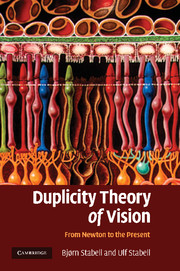Book contents
- Frontmatter
- Contents
- Acknowledgements
- 1 Introduction
- Part I The development of the basic ideas of the duplicity theory from Newton to G. E. Müller
- Part II The development of the duplicity theory from 1930–1966
- Part III Chromatic rod vision: a historical account
- Part IV Theories of sensitivity regulation of the rod and cone systems: a historical account
- 15 Introduction
- 16 Early photochemical explanations
- 17 Contribution of S. Hecht
- 18 Contribution of G. Wald: photochemical sensitivity regulation mechanisms of rods and cones
- 19 Relationship between amount of rhodopsin and sensitivity during dark adaptation
- 20 Post-receptor sensitivity regulation mechanisms
- 21 Rushton's AGC model
- 22 Contribution of H.B. Barlow
- 23 Rushton and Barlow compared
- 24 The Dowling-Rushton equation refuted
- 25 Several mechanisms involved in sensitivity regulation
- 26 Sensitivity regulation due to rod-cone interaction
- 27 Modern conceptions of sensitivity regulation
- Part V Factors that triggered the paradigm shifts in the development of the duplicity theory
- References
- Index
19 - Relationship between amount of rhodopsin and sensitivity during dark adaptation
Published online by Cambridge University Press: 22 January 2010
- Frontmatter
- Contents
- Acknowledgements
- 1 Introduction
- Part I The development of the basic ideas of the duplicity theory from Newton to G. E. Müller
- Part II The development of the duplicity theory from 1930–1966
- Part III Chromatic rod vision: a historical account
- Part IV Theories of sensitivity regulation of the rod and cone systems: a historical account
- 15 Introduction
- 16 Early photochemical explanations
- 17 Contribution of S. Hecht
- 18 Contribution of G. Wald: photochemical sensitivity regulation mechanisms of rods and cones
- 19 Relationship between amount of rhodopsin and sensitivity during dark adaptation
- 20 Post-receptor sensitivity regulation mechanisms
- 21 Rushton's AGC model
- 22 Contribution of H.B. Barlow
- 23 Rushton and Barlow compared
- 24 The Dowling-Rushton equation refuted
- 25 Several mechanisms involved in sensitivity regulation
- 26 Sensitivity regulation due to rod-cone interaction
- 27 Modern conceptions of sensitivity regulation
- Part V Factors that triggered the paradigm shifts in the development of the duplicity theory
- References
- Index
Summary
On the discoveries of Boll (1877) and Kühne (1877, 1878, 1879) that rhodopsin in rods is engaged in reversible cycles of bleaching and regeneration, Parinaud (1885) had suggested that changes in visual sensitivity were due to variation in the amount of rhodopsin. This view had a great impact. Thus, for a long period it became generally accepted that the alteration of visual sensitivity in light and dark adaptation reflected changes in the concentration of the visual pigments and hence their capacity to absorb light.
RESULTS OF TANSLEY
Tansley (1931) appears to be the first to measure quantitatively the change in rhodopsin concentration during dark adaptation. She light adapted albino rats almost completely and then measured the quantity of rhodopsin extracted after varying times (from 2.5 to 1140 min) in the dark. The results obtained could be explained both by bimolecular and monomolecular reactions, although the monomolecular reaction was found to fit slightly better. In accordance with Parinaud's (1885) assumption, she obtained a striking similarity between the regeneration curve of rhodopsin of the albino rat and the dark-adaptation curve measured in humans. Hence, she suggested that the sensitivity during dark adaptation was proportional to the amount of rhodopsin present in the retina.
RESULTS OF GRANIT
This simple photochemical theory of dark adaptation, however, eventually met with serious difficulties. Thus, evidence put forward by Granit et al. (1938, 1939) strongly suggested that the amount of rhodopsin played only a minor role in sensitivity regulation during light and dark adaptation.
- Type
- Chapter
- Information
- Duplicity Theory of VisionFrom Newton to the Present, pp. 147 - 156Publisher: Cambridge University PressPrint publication year: 2009



